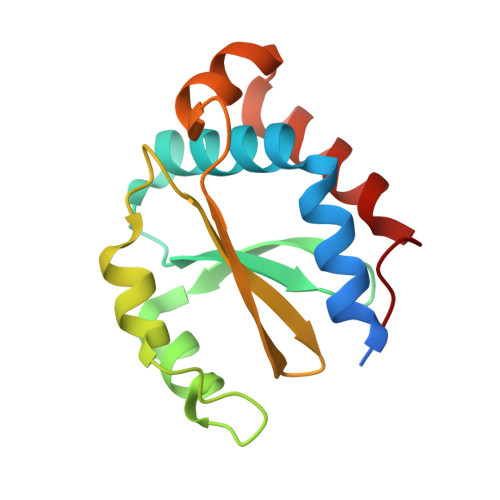Molecular interactions of the chaperone CcmS and carboxysome shell protein CcmK1 that mediate beta-carboxysome assembly.
Cheng, J., Li, C.Y., Meng, M., Li, J.X., Liu, S.J., Cao, H.Y., Wang, N., Zhang, Y.Z., Liu, L.N.(2024) Plant Physiol
- PubMed: 39172695
- DOI: https://doi.org/10.1093/plphys/kiae438
- Primary Citation of Related Structures:
8ZLH, 8ZLZ - PubMed Abstract:
The carboxysome is a natural proteinaceous organelle for carbon fixation in cyanobacteria and chemoautotrophs. It comprises hundreds of protein homologs that self-assemble to form a polyhedral shell structure to sequester cargo enzymes, ribulose 1,5-bisphosphate carboxylase/oxygenase (Rubisco) and carbonic anhydrases. How these protein components assemble to construct a functional carboxysome is a central question in not only understanding carboxysome structure and function but also synthetic engineering of carboxysomes for biotechnological applications. Here, we determined the structure of the chaperone protein CcmS, which has recently been identified to be involved in β-carboxysome assembly, and its interactions with β-carboxysome proteins. The crystal structure at 1.99 Å resolution reveals CcmS from Nostoc sp. PCC 7120 forms a homodimer, and each CcmS monomer consists of five α-helices and four β-sheets. Biochemical assays indicate that CcmS specifically interacts with the C-terminal extension of the carboxysome shell protein CcmK1, but not the shell protein homolog CcmK2 or the carboxysome scaffolding protein CcmM. Moreover, we solved the structure of a stable complex of CcmS and the C-terminus of CcmK1 at 1.67 Å resolution and unveiled how the CcmS dimer interacts with the C-terminus of CcmK1. These findings allowed us to propose a model to illustrate CcmS-mediated β-carboxysome assembly by interacting with CcmK1 at the outer shell surface. Collectively, our study provides detailed insights into the accessory factors that drive and regulate carboxysome assembly, thereby improving our knowledge of carboxysome structure, function, and bioengineering.
Organizational Affiliation:
MOE Key Laboratory of Evolution and Marine Biodiversity, Frontiers Science Center for Deep Ocean Multispheres and Earth System & College of Marine Life Sciences, Ocean University of China, Qingdao 266003, China.














